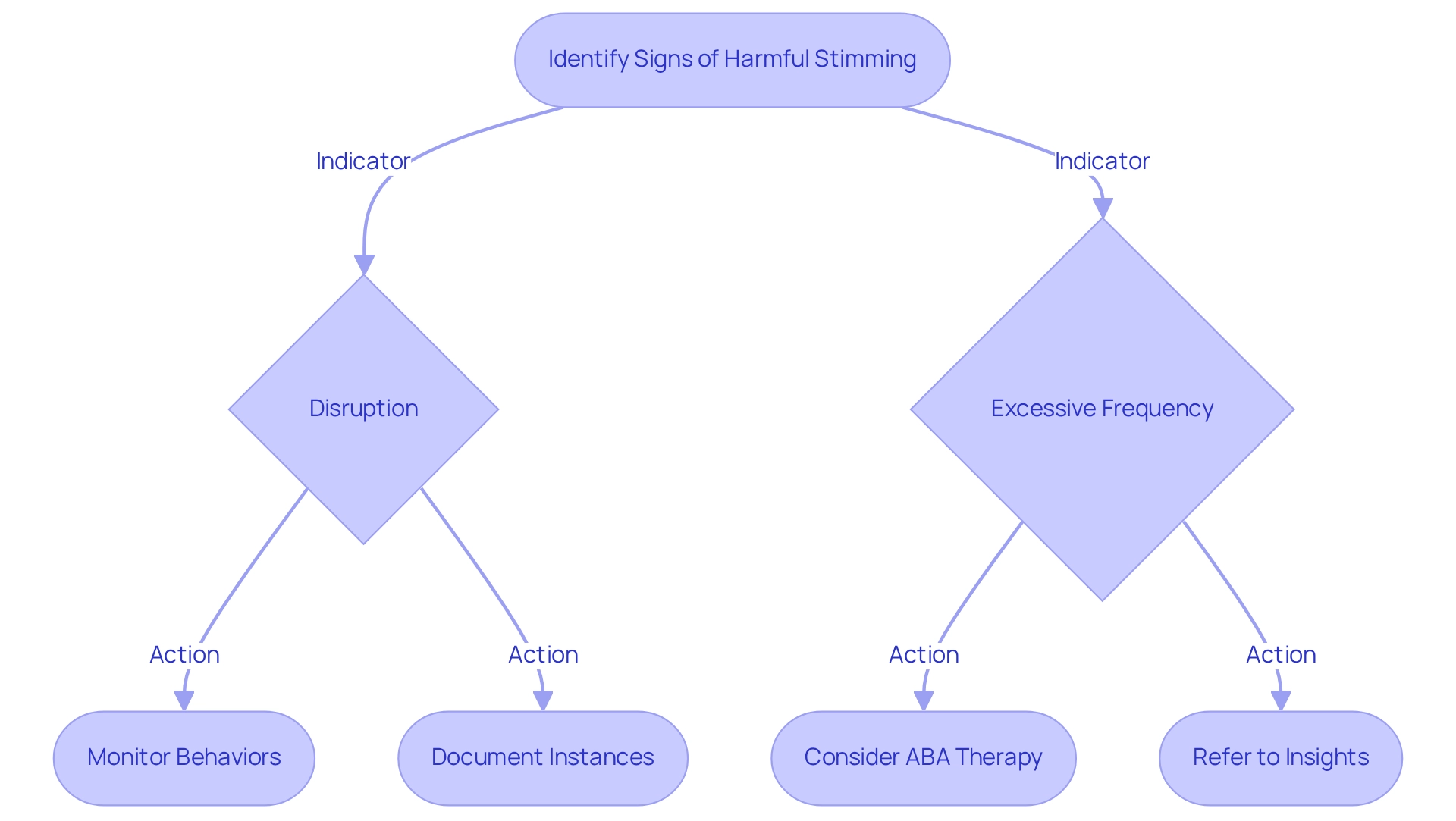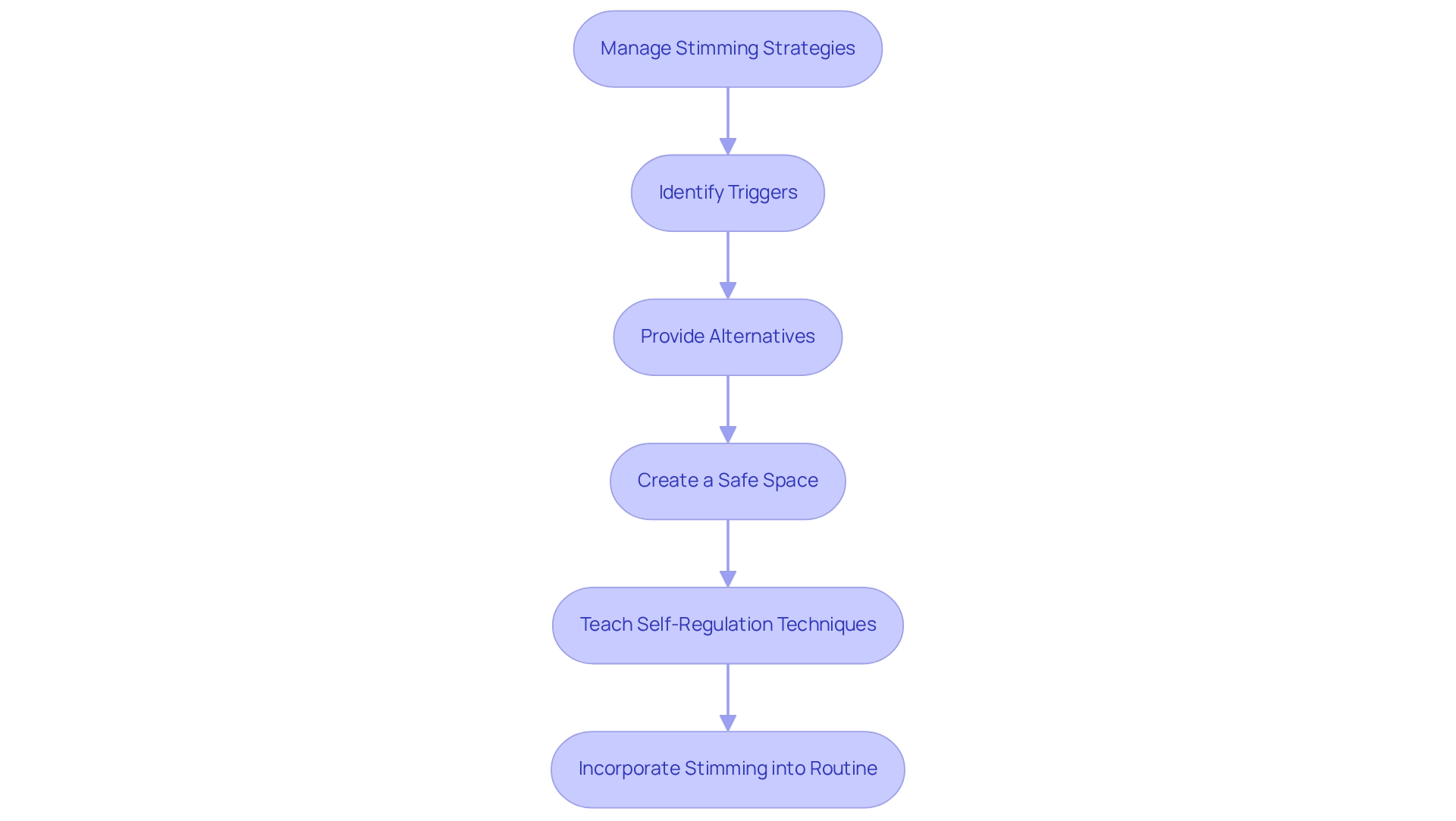Overview
Stimming is not inherently bad; in fact, it plays a vital role in self-soothing and emotional regulation, especially for individuals with autism. It's essential to recognize the context of stimming behaviors. While they can be beneficial, there are harmful signs to watch for, such as disruptions to daily life or excessive frequency. These signs call for careful management and supportive strategies.
Understanding stimming can be a journey for many parents. Imagine a child who finds comfort in repetitive movements during overwhelming moments. This behavior can be a source of calm amidst chaos. However, when stimming begins to interfere with daily activities, it may be time to seek additional support.
As we navigate these challenges together, remember that you are not alone. There are resources available to help you understand and manage stimming behaviors effectively. We encourage you to share your experiences and insights, as your story may resonate with others facing similar situations. Let’s foster a community of support and understanding.
Introduction
In the intricate world of autism, stimming—short for self-stimulatory behavior—emerges as a vital yet often misunderstood aspect of daily life. This behavior, characterized by repetitive movements or sounds, serves as a coping mechanism for many individuals, helping them navigate sensory overload and emotional fluctuations. While it can be a harmless expression of self-soothing, certain forms of stimming may signal deeper concerns that require attention.
This article delves into the multifaceted nature of stimming, exploring its purpose and identifying harmful patterns. We aim to offer effective strategies for management, fostering a deeper understanding of stimming. By doing so, caregivers and professionals can better support individuals on the autism spectrum, promoting both their well-being and development. Together, we can create a more compassionate and informed community.
Define Stimming and Its Purpose
Stimming, which stands for self-stimulatory behavior, involves repetitive movements or sounds that many individuals, especially those with autism, engage in to soothe themselves or manage sensory input. Common forms of stimming include hand-flapping, rocking, and various vocalizations. These behaviors can serve multiple purposes: they may help alleviate anxiety, express excitement, or aid in maintaining focus.
Recognizing that self-stimulatory actions often act as coping strategies is essential for caregivers. This understanding allows for a more compassionate approach, replacing criticism with support. It's important to grasp the context in which stimming occurs; doing so is vital for effective management and encouragement.
Stimming is a natural behavior, deeply linked to sensory processing. It plays a crucial role in emotional regulation and self-soothing. It's important to remember that not all self-stimulatory behaviors are harmful, and the question of is stimming bad should be considered carefully. By understanding their context, we can foster a more supportive environment for those who engage in them. If you have experiences or insights to share, we encourage you to join the conversation in the comments or through our newsletter.
Identify Signs of Harmful Stimming
While self-soothing behaviors can be a harmless coping mechanism for sensory overload or emotional distress, it's important to recognize their vital role in self-expression and emotional regulation for autistic individuals. However, certain indicators suggest that self-stimulatory behaviors may be harmful, which raises the question: is stimming bad, and it's essential to be aware of these signs. Studies indicate that approximately 30% of children with autism engage in self-harming repetitive actions, highlighting the need for vigilance.
- Disruption: Repetitive actions that interfere with daily activities, social interactions, or learning environments may require intervention. For instance, a recent study on repetitive movements and self-identity revealed that societal acceptance significantly influences how individuals perceive their repetitive actions, underscoring the importance of supportive environments.
- Excessive Frequency: If repetitive movements occur so frequently that they hinder engagement in essential activities, this may pose a problem. Experts suggest that self-stimulatory behavior should not overshadow other developmental opportunities, and they often discuss whether 'is stimming bad' in inappropriate contexts, as engaging in such behaviors in socially unacceptable or disruptive environments can lead to negative consequences, both socially and emotionally. Understanding the context of repetitive behaviors is crucial for effective management.
Action Steps:
- Monitor these behaviors closely to identify concerning patterns.
- Document instances of harmful behaviors to discuss with professionals, ensuring a comprehensive approach to support.
- Consider how ABA therapy can help develop self-confidence in children with autism, as it provides strategies to manage these behaviors effectively.
- Refer to recent insights on enhancing learning environments for children with autism, which highlight how ABA therapy can improve focus and attention, linking these strategies to the action steps suggested.

Implement Strategies for Managing Stimming
Understanding whether stimming is bad can be a journey, and there are several strategies that can help along the way:
- Identify Triggers: Take a moment to observe and document the situations that lead to increased sensory behaviors. Understanding whether stimming is bad is key; it allows for thoughtful modifications to the environment or routine that can make a significant difference.
- Provide Alternatives: Consider offering alternative activities that satisfy the same sensory needs. Fidget toys or sensory bins can serve as wonderful outlets, providing comfort and engagement.
- Create a Safe Space: It’s essential to designate a calming area where the individual can engage in self-soothing behaviors without fear of judgment or interruption. This sanctuary can be a valuable retreat during overwhelming moments.
- Teach Self-Regulation Techniques: Empower individuals by helping them recognize when they feel the need to stim. Providing them with tools to manage their emotions in healthier ways fosters independence and emotional resilience.
- Incorporate Stimming into Routine: Scheduling specific times for stimming can be beneficial. This approach not only reduces occurrences during inappropriate times but also creates a harmonious balance between self-soothing and social interaction.
As you explore these strategies, remember to collaborate with the individual to discover what resonates most with them. It’s important to consistently assess and adapt your approaches based on what works best. Together, you can navigate this journey with understanding and compassion.

Seek Professional Support and Resources
When addressing repetitive actions, seeking professional assistance is not just beneficial; it can be essential for your child's development. Consider these valuable resources that can make a difference:
- Behavioral Therapists: These professionals, trained in ABA therapy, offer tailored strategies and interventions that can significantly improve outcomes for children exhibiting stimming behaviors. Research shows that ABA therapy effectively reduces challenging behaviors and enhances social skills. In fact, a study documented 18 successful entries in June 2010, highlighting its importance as a resource for families.
- Occupational Therapists: These experts focus on processing challenges and assist in creating coping techniques to lessen the impacts of self-stimulatory behavior. Their interventions often include sensory integration techniques that promote better self-regulation, helping your child thrive.
- Support Groups: Connecting with other parents and caregivers can provide emotional support and shared experiences, fostering a sense of community. As writer Karen Wang beautifully states, "Talking openly about challenges helps us heal." Engaging in these groups can help you feel less isolated and more empowered in your advocacy for your child.
- Educational Resources: Books, workshops, and online courses can enhance your understanding and provide new strategies for managing sensory behaviors. While these resources offer valuable insights into the multifactorial nature of autism, including genetic and environmental factors that may affect conduct, it's important to remember that the Parent's Guide to Cord Blood Foundation does not replace medical advice from a physician.
By leveraging these resources, you can create a supportive environment that not only addresses the question of is stimming bad but also promotes your child's overall development and well-being. Remember, you are not alone on this journey.
Conclusion
Understanding the complexities of stimming is crucial for supporting individuals on the autism spectrum. This article highlights the essential nature of stimming as a self-soothing mechanism that helps manage sensory overload and emotional fluctuations. By recognizing the various forms of stimming, its purposes, and the contexts in which it occurs, caregivers can approach this behavior with empathy and understanding.
While stimming can be a harmless expression of self-regulation, it is vital to identify signs of potentially harmful stimming that may require intervention. Being vigilant for behaviors that might lead to self-injury, disruption, or excessive frequency allows caregivers to take proactive steps to ensure the individual’s well-being. Implementing effective management strategies—such as identifying triggers and providing alternatives—can foster a supportive environment that balances self-soothing with social engagement.
Finally, seeking professional support from behavioral and occupational therapists can enhance the management of stimming behaviors. By utilizing available resources, caregivers empower themselves and their loved ones, creating a more compassionate and informed community. Emphasizing understanding, empathy, and proactive support will ultimately promote the well-being and development of individuals with autism, allowing them to thrive in their unique ways.
Frequently Asked Questions
What is stimming?
Stimming, or self-stimulatory behavior, involves repetitive movements or sounds that individuals, particularly those with autism, engage in to soothe themselves or manage sensory input.
What are common forms of stimming?
Common forms of stimming include hand-flapping, rocking, and various vocalizations.
What purposes does stimming serve?
Stimming can help alleviate anxiety, express excitement, or aid in maintaining focus.
Why is it important for caregivers to understand stimming?
Recognizing self-stimulatory actions as coping strategies allows caregivers to adopt a more compassionate approach, replacing criticism with support.
How is stimming related to sensory processing?
Stimming is a natural behavior closely linked to sensory processing, playing a crucial role in emotional regulation and self-soothing.
Are all self-stimulatory behaviors harmful?
Not all self-stimulatory behaviors are harmful; it is important to consider the context in which stimming occurs for effective management and encouragement.
How can caregivers respond to stimming behaviors?
Caregivers can foster a supportive environment by understanding the context of stimming and offering encouragement rather than criticism.




